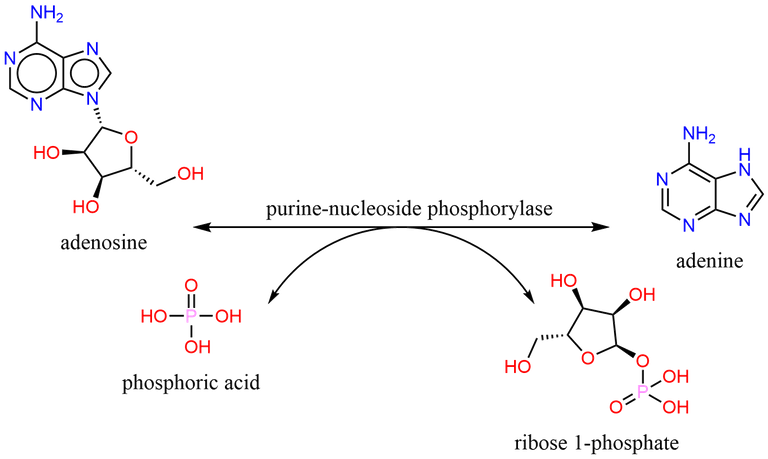Hello everyone, Okay today, I want to do a little bit of molecular biochemistry, or should I say molecular biology, anyways science is intertwined with one another no matter the area, and in today's post, let's do Purine synthesis but before then, let me quickly say a happy new week to everyone. Actually, a friend invited me to a party over the weekend but I turned down the offer because I didn't want to spend my entire day at a party, thereby preventing me from getting the proper rest I needed. That doesn't mean I do not like parties because I am the life of the party but I just needed the weekend to myself, and while I enjoyed my weekend, I hope you did the same on your end, and welcome to a new week.
DNA is a genetic coding that is found in the nucleus of Eukaryotic cells. DNA is a polymer of nucleotides known as Pyrimidines and Purines, so when I said I wanted to treat Purine synthesis, I hope you understand where I am heading now. A nucleotide is composed of a nitrogenous base product, Pentose sugars (deoxyribose pentose sugar, ribose sugar), and phosphate groups. Let's discuss the nitrogenous base and Purines composition that concerns us are;
Adenine = 6-amino purine
Guanine = 2-amino-6-oxy purine
Hypoxanthine = 6-oxy purine
Xanthine = 2,6-dioxy purine
While pyrimidines compositions include;
Uracil = 2,4-dioxy pyrimidine
Thymine = 2,4-dioxy-5-methyl pyrimidine
Cytosine = 2-oxy-4-amino pyrimidine
Orotic acid = 2,4-dioxy-6-carboxy pyrimidine
DNA can be used as a source of energy by physiological mediators such as Cyclic AMP and Cyclic GMP which uses Purines. Adenine can also be converted into ATP. Purine doesn't fall from Jupiter, we get purine in our system from different sources which include Diet, Direct synthesis of purines, and salvage pathways in the system. Purine is very important in the synthesis of RNA to DNA.
Purine synthesis has to do with carbon and Nitrogen. Nitrogen is gotten from Amino acids such as Aspartate, Glutamine, and Glycine, and they play a role in purine synthesis. Carbon in purine synthesis has its sources from Carbon-IV-Oxide and Tetrahydrofolate. When the body is synthesizing purine, it is aiming to create AMP and GMP as they can be used to produce energy or function in the RNA and DNA formation in the case of AMP, and also in the case of GMP, it can become GTP, Cyclic-GMP, and so on. Purine synthesis starts from the Ribose-5-phosphate which comes from the HMP shunt. The Ribose-5-phosphate creates the Phosphoribosyl pyrophosphate (PRPP) molecule. The Phosphoribosyl pyrophosphate (PRPP) is converted into inosine monophosphate (IMP) which is purine's first product. Inosine monophosphate (IMP) becomes AMP and GMP with Glutamine PRPP Amidotransferase being the rate-limiting enzyme. This enzyme plays a role in the conversion of Phosphoribosyl pyrophosphate (PRPP) to inosine monophosphate (IMP).
Ribose-5-phosphate > Phosphoribosyl pyrophosphate (PRPP) > Inosine monophosphate (IMP) > Adenosine MonoPhosphate (AMP) and Guanisine MonoPhosphate (GMP).
Let me quickly explain PRPP synthetase. Phosphoribosyl Pyrophosphate is a Ribose-5-phosphate with a pyrophosphate group (two condensed phosphate groups). It is used in purine and pyrimidine synthesis but remember I am discussing purine. PPRP is used to make the sugar backbone in all nucleotides. During the conversion of PRPP into IMP, Nitrogen products (Aspartate, Glutamine, and Glycine) are infused from the Amino Acids, Tetrahydrofolate, and carbon dioxide from Carbon, all as a result of the enzyme Glutamine-PRPP Amidotransferase. AMP can be converted into ATP, and GMP can be converted into GTP, which is used in RNA synthesis. ATP can be converted to dATP, and GTP can be converted into dGTP which is important in DNA synthesis. The main goal of purine Synthesis is to make AMP and GMP.

wikimedia
When Purine has been made and used up, it is either recycled or removed from the body. Excessive amounts can be excreted as uric acid, and when it is not excreted, it can lead to Gout. To salvage purines, it has to create the AMP GMP and IMP molecule and to salvage purine, PRPP is also required. To salvage purine, specific enzymes are required such as Hypoxanthine-Guanine Phosphoribosyltransferase (HGPRT) which is responsible for Hypoxanthine/guanine salvage, and Adenine Phosphoribosyltransferase (APRT). The pathway starts with PRPP where APRT is used to create Adenine, or HGPRT is used to create Guanine or Hypoxanthine. With Adenine and Guanine, adding phosphate makes it AMP and GMP, while Hypoxantine will become IMP which will then be converted into AMP and GMP via purine synthesis.
Clinically, to stop the production of purines as well as the salvage of purine, drugs such as 6-mercaptopurine are used. It mimics hypoxanthine and guanine affecting the HGPRT enzyme where it will create Thioinosinic acid will inhibit the production of GMP which will prevent the production of dGTP which will affect DNA production. Also, Thioinosinic acid will inhibit the production of Hypoxanthine which will reduce the creation of IMP, and remember that IMP can be converted to AMP and GMP, so there will be a decrease in both AMP and GMP.
Phosphoribosyl Diphosphate (PRPP): Biosynthesis, Enzymology, Utilization, and Metabolic Significance

Thanks for your contribution to the STEMsocial community. Feel free to join us on discord to get to know the rest of us!
Please consider delegating to the @stemsocial account (85% of the curation rewards are returned).
Thanks for including @stemsocial as a beneficiary, which gives you stronger support.
Hello, quite a complex topic for some people, I remember that in my days as a medical student, biochemistry was a bit of a complex subject, very abstract, but also very interesting and important. Excellent explanation.
It is good to have you here, thanks a lot for reading. Biochemistry is always a bit complex for lots of students, expecially when it is not the major course being studied.